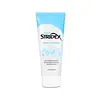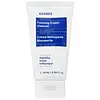What's inside
What's inside
 Key Ingredients
Key Ingredients

 Benefits
Benefits

 Concerns
Concerns

 Ingredients Side-by-side
Ingredients Side-by-side

Water
Skin ConditioningStearic Acid
CleansingGlycerin
HumectantMyristic Acid
CleansingLauric Acid
CleansingPotassium Hydroxide
BufferingPEG-8
HumectantPEG-60 Glyceryl Isostearate
Potassium Cocoyl Glycinate
Cocamidopropyl Betaine
CleansingGlyceryl Stearate
EmollientPEG-100 Stearate
Polysorbate 20
EmulsifyingSorbitan Olivate
EmulsifyingPolyquaternium-7
Propanediol
SolventParfum
MaskingSodium Chloride
MaskingSodium Methyl Cocoyl Taurate
CleansingChlorphenesin
AntimicrobialSalicylic Acid
MaskingMethyl Diisopropyl Propionamide
MaskingCaprylyl Glycol
EmollientDisodium EDTA
Tocopheryl Acetate
AntioxidantSodium Hyaluronate
HumectantCentella Asiatica Extract
CleansingFicus Carica Fruit Extract
HumectantAcmella Oleracea Extract
Skin ProtectingAmaranthus Caudatus Seed Extract
Skin ConditioningUlmus Davidiana Root Extract
Skin ConditioningUndaria Pinnatifida Extract
Skin ConditioningMenthyl Lactate
MaskingButylene Glycol
HumectantEthyl Menthane Carboxamide
TonicEthylhexylglycerin
Skin Conditioning1,2-Hexanediol
Skin ConditioningAloe Barbadensis Leaf Extract
EmollientLimonene
PerfumingLinalool
PerfumingWater, Stearic Acid, Glycerin, Myristic Acid, Lauric Acid, Potassium Hydroxide, PEG-8, PEG-60 Glyceryl Isostearate, Potassium Cocoyl Glycinate, Cocamidopropyl Betaine, Glyceryl Stearate, PEG-100 Stearate, Polysorbate 20, Sorbitan Olivate, Polyquaternium-7, Propanediol, Parfum, Sodium Chloride, Sodium Methyl Cocoyl Taurate, Chlorphenesin, Salicylic Acid, Methyl Diisopropyl Propionamide, Caprylyl Glycol, Disodium EDTA, Tocopheryl Acetate, Sodium Hyaluronate, Centella Asiatica Extract, Ficus Carica Fruit Extract, Acmella Oleracea Extract, Amaranthus Caudatus Seed Extract, Ulmus Davidiana Root Extract, Undaria Pinnatifida Extract, Menthyl Lactate, Butylene Glycol, Ethyl Menthane Carboxamide, Ethylhexylglycerin, 1,2-Hexanediol, Aloe Barbadensis Leaf Extract, Limonene, Linalool
Water
Skin ConditioningSodium Cocoyl Isethionate
CleansingCoco-Betaine
CleansingCetearyl Alcohol
EmollientDisodium Lauryl Sulfosuccinate
CleansingZea Mays Starch
AbsorbentGlycerin
HumectantCocamidopropyl Betaine
CleansingSodium Chloride
MaskingMagnesium Aluminum Silicate
AbsorbentSodium Methyl Cocoyl Taurate
CleansingGlyceryl Laurate
EmollientSclerotium Gum
Emulsion StabilisingAlpha-Glucan Oligosaccharide
CleansingAmaranthus Caudatus Seed Extract
Skin ConditioningChlorella Vulgaris Extract
Skin ConditioningCitric Acid
BufferingHydrogenated Castor Oil
EmollientHydrolyzed Rice Protein
Skin ConditioningLactic Acid
BufferingLactis Proteinum
Skin ConditioningLactobacillus
Skin ConditioningLactose
HumectantLaminaria Digitata Extract
Skin ProtectingLonicera Caprifolium Flower Extract
PerfumingLonicera Japonica Flower Extract
Skin ConditioningMaltodextrin
AbsorbentMaris Aqua
HumectantPentylene Glycol
Skin ConditioningPhenethyl Alcohol
MaskingPolymnia Sonchifolia Root Juice
Skin ConditioningSaccharide Isomerate
HumectantSodium Cocoyl Alaninate
Sodium Phytate
Titanium Dioxide
Cosmetic ColorantYogurt
Skin ProtectingYogurt Powder
Phenoxyethanol
PreservativeSodium Benzoate
MaskingParfum
MaskingWater, Sodium Cocoyl Isethionate, Coco-Betaine, Cetearyl Alcohol, Disodium Lauryl Sulfosuccinate, Zea Mays Starch, Glycerin, Cocamidopropyl Betaine, Sodium Chloride, Magnesium Aluminum Silicate, Sodium Methyl Cocoyl Taurate, Glyceryl Laurate, Sclerotium Gum, Alpha-Glucan Oligosaccharide, Amaranthus Caudatus Seed Extract, Chlorella Vulgaris Extract, Citric Acid, Hydrogenated Castor Oil, Hydrolyzed Rice Protein, Lactic Acid, Lactis Proteinum, Lactobacillus, Lactose, Laminaria Digitata Extract, Lonicera Caprifolium Flower Extract, Lonicera Japonica Flower Extract, Maltodextrin, Maris Aqua, Pentylene Glycol, Phenethyl Alcohol, Polymnia Sonchifolia Root Juice, Saccharide Isomerate, Sodium Cocoyl Alaninate, Sodium Phytate, Titanium Dioxide, Yogurt, Yogurt Powder, Phenoxyethanol, Sodium Benzoate, Parfum
 Reviews
Reviews

Ingredients Explained
These ingredients are found in both products.
Ingredients higher up in an ingredient list are typically present in a larger amount.
This ingredient comes from the seed of the velvet flower. It has skin hydrating, nourishing, and antioxidant properties.
This seed is rich in peptides, fatty acids, squalene, vitamin C, and vitamin E.
According to manufacturer, this ingredient is great for adding softness and shine to hair.
Learn more about Amaranthus Caudatus Seed ExtractCocamidopropyl Betaine is a fatty acid created by mixing similar compounds in coconut oil and dimethylaminopropylamine, a compound with two amino groups.
This ingredient is a surfactant and cleanser. It helps gather the dirt, pollutants, and other impurities in your skin to be washed away. It also helps thicken a product and make the texture more creamy.
Being created from coconut oil means Cocamidopropyl Betaine is hydrating for the skin.
While Cocamidopropyl Betaine was believed to be an allergen, a study from 2012 disproved this. It found two compounds in unpure Cocamidopropyl Betaine to be the irritants: aminoamide and 3-dimethylaminopropylamine. High-grade and pure Cocamidopropyl Betaine did not induce allergic reactions during this study.
Learn more about Cocamidopropyl BetaineGlycerin is already naturally found in your skin. It helps moisturize and protect your skin.
A study from 2016 found glycerin to be more effective as a humectant than AHAs and hyaluronic acid.
As a humectant, it helps the skin stay hydrated by pulling moisture to your skin. The low molecular weight of glycerin allows it to pull moisture into the deeper layers of your skin.
Hydrated skin improves your skin barrier; Your skin barrier helps protect against irritants and bacteria.
Glycerin has also been found to have antimicrobial and antiviral properties. Due to these properties, glycerin is often used in wound and burn treatments.
In cosmetics, glycerin is usually derived from plants such as soybean or palm. However, it can also be sourced from animals, such as tallow or animal fat.
This ingredient is organic, colorless, odorless, and non-toxic.
Glycerin is the name for this ingredient in American English. British English uses Glycerol/Glycerine.
Learn more about GlycerinParfum is a catch-all term for an ingredient or more that is used to give a scent to products.
Also called "fragrance", this ingredient can be a blend of hundreds of chemicals or plant oils. This means every product with "fragrance" or "parfum" in the ingredients list is a different mixture.
For instance, Habanolide is a proprietary trade name for a specific aroma chemical. When used as a fragrance ingredient in cosmetics, most aroma chemicals fall under the broad labeling category of “FRAGRANCE” or “PARFUM” according to EU and US regulations.
The term 'parfum' or 'fragrance' is not regulated in many countries. In many cases, it is up to the brand to define this term.
For instance, many brands choose to label themselves as "fragrance-free" because they are not using synthetic fragrances. However, their products may still contain ingredients such as essential oils that are considered a fragrance by INCI standards.
One example is Calendula flower extract. Calendula is an essential oil that still imparts a scent or 'fragrance'.
Depending on the blend, the ingredients in the mixture can cause allergies and sensitivities on the skin. Some ingredients that are known EU allergens include linalool and citronellol.
Parfum can also be used to mask or cover an unpleasant scent.
The bottom line is: not all fragrances/parfum/ingredients are created equally. If you are worried about fragrances, we recommend taking a closer look at an ingredient. And of course, we always recommend speaking with a professional.
Learn more about ParfumChances are, you eat sodium chloride every day. Sodium Chloride is also known as table salt.
This ingredient has many purposes in skincare: thickener, emulsifier, and exfoliator.
You'll most likely find this ingredient in cleansers where it is used to create a gel-like texture. As an emulsifier, it also prevents ingredients from separating.
There is much debate on whether this ingredient is comedogenic. The short answer - comedogenic ratings don't tell the whole story. Learn more about comegodenic ratings here.
The concensus about this ingredient causing acne seems to be divided. Research is needed to understand if this ingredient does cause acne.
Scrubs may use salt as the primary exfoliating ingredient.
Learn more about Sodium ChlorideThis gentle cleansing and foaming ingredient is known for leaving a smooth feeling in skin and hair. It is made using coconut oil.
According to the manufacturer, it is soluble in water and has resistance to hard water, acid, and alkali.
Due to its coconut base, it may not be Malassezia folliculitis safe.
Learn more about Sodium Methyl Cocoyl TaurateWater. It's the most common cosmetic ingredient of all. You'll usually see it at the top of ingredient lists, meaning that it makes up the largest part of the product.
So why is it so popular? Water most often acts as a solvent - this means that it helps dissolve other ingredients into the formulation.
You'll also recognize water as that liquid we all need to stay alive. If you see this, drink a glass of water. Stay hydrated!
Learn more about Water